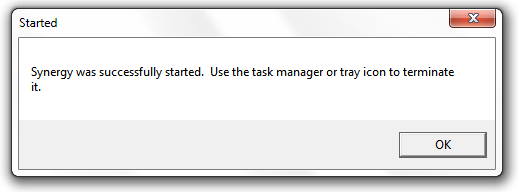Recently, Thomas reviewed a program called InputDirector, which lets you use a single keyboard and mouse across multiple computers. For some time, I’ve been using Synergy, which does the same thing. In this review, I show you the features of Syngery and show you how to use it.
| Windows Guides’ Rating | Compatible with | System |
 PROS: Lightweight, does what it claims, can be very useful for Home Theater PC setups as well as multi-PC offices etc. PROS: Lightweight, does what it claims, can be very useful for Home Theater PC setups as well as multi-PC offices etc.
CONS: Can be a little difficult to get working as you expect it to. Cannot link computers on different subnets or networks. VERDICT: If you find you don’t like InputDirector and want to give Synergy a try, I think you’ll find you really like it. PRICE: Free VERSION REVIEWED: 1.3.4 DOWNLOAD: Synergy |
Synergy Features
Synergy’s function is, in essence, very simple: it allows you to control multiple PCs with the use of one keyboard and mouse. You need to install Synergy on each computer and then set one up as the “server” and the other PCs and the “clients”.
Synergy also lets you share the clipboard and screensaver between your computers.
Synergy doesn’t take much setup and once complete, is a breeze to use–I highly recommend it.
How to Use Synergy
To use Synergy:
1. Install Synergy on every computer you want under control of your “server” and also on your server.
2. Start Synergy on the client computers, select Use another computer’s shared keyboard and mouse (client), type the name of your server*, and click Start.
* To get your server name, click on the Advanced… button and type the name you wish to use in the Screen Name field.

3. Open Synergy on your “server” (the computer that you’ll use to control the other computers connected.) Select Share this computer’s keyboard and mouse (server), and click Configure…

4. Under screens, click the plus sign and add each client, by Computer name*, to the list.
* To get your computer’s name, use your client’s Computer name. To get this, click the Start button, right click Computer, and click Properties. The name is listed next to Computer name.
5. Now you’ll need to tell Synergy where each screen is. In the example below, I have three computers next to each other:
GVD – SVUL – DXPL
I set the following rules (see screenshot), which states GVD is left of SVUL, SVUL is left of DXPL, DXPL is right of SVUL, and SVUL is right of GVD. I recommend leaving the percentages as is (unless you have a need to change them i.e. two screens, one on top of the other, to the left of one screen.)

6. Press OK and click Start.

You may get a pop up from your Firewall and you’ll need to allow the connection. If you are using third party software, you may need to add a manual rule to allow Synergy to communicate between your computers.
Please note: It can take up to one minute to establish a connection between your computers so please be patient.
Other Settings for Synergy
I use Synergy to control my Home Theater PC (HTPC) when I’m using my laptop. One thing I noticed, after installing Synergy, was that the screen didn’t power off after the HTPC was idle (a useful feature as I often walk away from my TV and leave it wasting electricity.) To fix this issue, I changed the setting on the server to not Synchronize screen savers. (As my laptop has a different screen power setting.)

You can also autostart Synergy when you start your PC (useful if you’re making this a permanent setup.)

At any time, you can see which computers are connected together by right clicking the Synergy icon in the system tray and clicking Show status.

I really like Synergy; it uses minimal system resources and just works. The only problem I’ve found is if you Remote Desktop into from a Synergy connected PC to another Synergy connected PC and move the mouse out of the screen (confused yet), the clipboard stops working; however, this is not really a problem — more of a quirk.
Download Synergy
Download Synergy |
About Rich
Rich is the owner and creator of Windows Guides; he spends his time breaking things on his PC so he can write how-to guides to fix them.
- Web
- |
- |
- |
- |
- Google+
- |
- More Posts (1019)
Search Windows Guides